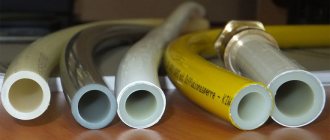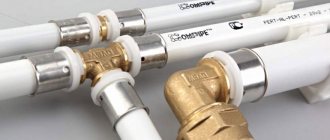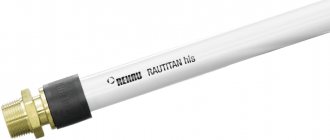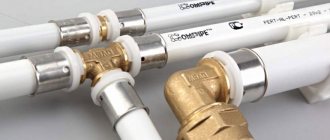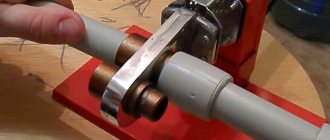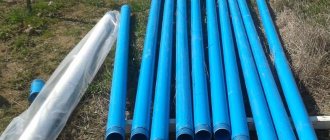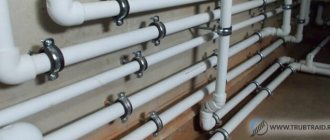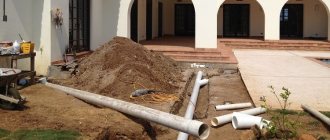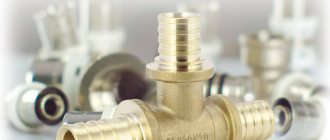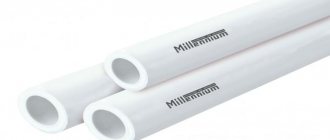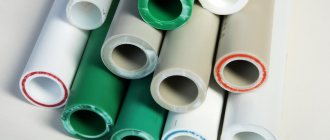How to choose pipes
When choosing products, you need to take into account the visual characteristics of the pipes, as well as other features:
- The materials must be homogeneous and not contain any inclusions;
- The pipes must be marked and the GOST in accordance with which they were manufactured must be indicated;
- There should be no unpleasant odor in such pipes;
- The wall thickness should be the same along the entire length of the product;
- The surface of the pipe must be smooth.
If the selected pipe fully complies with all the above points, the product can be called of sufficient quality. This pipe is perfect for installing a main line in a cold water supply system. Low-quality products can only be used to satisfy simple technical needs.
A pipe that can be installed in a cold water supply system is marked with a blue stripe along the entire length of the product, painted black. Pipes used for such purposes are also painted blue.
HDPE pipes for cold water supply systems are often marked by embossing or printed; the following information is indicated on the products:
- Purpose and GOST;
- Overall dimensions, or the ratio of wall thickness and diameter;
- Product strength factor. PE100 high quality collectors. PE80 pipes of a lower class;
- Manufacturer's name;
- The footage is not indicated by all manufacturers.
The cost of products also requires attention in the process of choosing a suitable product. If the price per meter of pipe is lower compared to the market average, then the buyer is looking at a fake or a product intended for simple household needs.
A painful legacy
Just recently, some three decades ago, water distribution in all houses without exception was carried out with a steel water and gas pipe.
Reference: according to the uniform GOST 3262-75, both black and galvanized VGP pipes are produced.
In the 50-60s, during the construction of steel frames, very durable galvanization was used on threaded connections, but, alas, events developed from bad to worse: by the 70s it was replaced by cheaper and more technologically advanced black steel.
And, as practice has shown, it is completely in vain:
- The estimated service life of water pipelines has decreased from 30 to 15 years. The actual fact is severalfold: if the galvanized pipe perfectly performed its functions even after half a century of operation, then the author observed the first fistulas on black steel water pipes already 10 years after the house was commissioned;
Typical condition of steel risers after a decade and a half of service
Please note: painting water pipes only partially provides anti-corrosion protection. Paint quickly deteriorates on risers and hoses of cold water supply systems. To a large extent, this is due to the formation of condensation on the pipes: most of the year they are noticeably colder than the surrounding air.
- The pipes began to become overgrown with rust and mineral deposits. Water on the way to the water intake erodes soil and local rocks; mineral deposits on the walls of the water supply quickly and effectively reduce their throughput. Galvanization does not suffer from its formation, but black steel does so very, very much;
Steel cold water supply filling: inside view
Comment: the result of reducing the clearance in the water supply is a catastrophic drop in pressure at the peaks of water intake. In some cases, spills overgrown with sediment can be cleaned with ordinary sewer wire, but more often they are simply replaced with new ones.
- Sediment and rust began to not only reduce the throughput of bottlings and risers, but also increase the roughness of their walls, in full accordance with the well-known Shevelev tables, leading to an increase in the hydraulic resistance of the pipeline. This, in turn, aggravated the drop in pressure during active water withdrawal.
Rough walls provide greater resistance to fluid flow
Polyethylene pipes
Polyethylene pipes are marked according to their purpose, similar to products of other possible materials. Products can be wound into coils and coils if they have a small diameter. The high elasticity of the pipe can be maintained even in frosty winter conditions. Consequently, the polyethylene plumbing system is quite resistant to freezing. The walls of the pipe will only be slightly stretched by the ice. The pipes will be in their original size after the ice melts.
Let's consider the areas of application of polyethylene pipes:
- Underground water pipelines;
- Water supply inlets;
- Systems installed in dachas and temporary removable summer water pipes.
The service life of such devices is at least 50 years. The permissible operating pressure is 6-16 kgf/sq.m. cm.
Features of planning a country water supply system
Building a water supply system on a summer cottage is always more difficult than building a water supply system for a residential building or garage. The main problem is that formally you will need to build three branches:
- Plumbing with drinking water for a country house;
- Stationary water supply system for supplying technical water to the house and to watering points in the beds;
- A temporary structure or portable system of pipes and hoses for connecting drip and shower irrigation of beds, shrubs and trees.
For each system, you can choose your own version of plastic pipes that is most suitable for the task. In addition, the price of plastic pipes for water supply in the country is of no small importance. For example, if you try to draw up a water supply diagram for a country house, it will become clear that in this case everything will take no more than 20 m of pipes with three consumer points - for the kitchen, shower and toilet.
Such a water supply system can be easily assembled with your own hands from polypropylene pipes. The whole idea of installing a water supply system in a country house will cost a maximum of $150-200, provided it is connected to a centralized water supply system or to an already built well with a pump and outlet.
If you try to assemble a water supply system for an irrigation system using the same scheme, then the costs of purchasing and assembling plastic pipes alone can increase several times. For example, for a standard dacha plot of 6 acres, the total length of the pipeline laid in the ground is at least 100 linear meters; accordingly, the price of an irrigation branch of a polypropylene water pipeline will increase by at least 2-3 times. To this scheme it is worth adding a system of hose waterers and drip irrigation, for example, for a greenhouse or beds under film.
For your information! A properly planned and constructed plastic water supply can withstand 10-15 years of operation without major repairs or maintenance.
A country irrigation system assembled from rubber hoses and steel pipes, with a higher construction cost, lasts approximately half as long, so there is no real alternative to using plastic.
A typical design of a country plastic water supply system is shown in the diagram. As a rule, water supply to the beds was carried out in the form of several parallel pipelines with a diameter of 20 mm, which were connected in the form of a “comb” to the main pressure line with a cross-section of 40-50 mm.
To ensure the supply of irrigation water, one pressure irrigation and one supply line are sufficient to supply the house and fill the drip irrigation reservoir.
Polypropylene
Cold water pipes made of polypropylene attract many homeowners with their affordable price. The cost of products can reach 20-25 rubles per linear meter with a standard pipe diameter of 20 mm. To connect such pipes, special fittings are used, which are also affordable.
Other quality characteristics can also please users:
- The service life of products in which the operating temperature does not exceed 20 degrees can be 50 years or more.
- The operating pressure can range from 10 to 20 kg/sq.m. cm;
- Welded joints are durable and tight.
Polypropylene pipes can be hidden in grooves or cement screed without any leaks in the near future.
Requirements
The experience with steel pipelines was not only sad, but also in some way useful.
He allowed us to formulate requirements for pipes that make sense to buy to replace steel ones:
- They should have the longest possible service life (ideally, at least half a century). Agree that undertaking repairs to communications every few years is tedious and costly;
Practical consequence: pipes for hot and cold water supply must be corrosion-resistant, in particular, they must not form galvanic couples with other metals used in the installation of water pipelines.
- They should not suffer from deposits, which means an internal surface that is smooth and has low adhesive qualities;
Overgrown pipes lead to loss of water pressure
- It is desirable that pressure pipes for cold water supply have low thermal conductivity: in this case, the water supply will not be covered with drops of condensate during the hot season;
- The low cost of pipes and fittings for them, as well as the simplest possible connection of cold water supply pipes with each other and with shut-off valves, will also be a big plus.
What about the technical specifications? What are the requirements for the strength of the water supply?
Very democratic. Pipelines for cold and hot water supply operate under fundamentally different conditions: if with a centralized supply of hot water supply water hammers and exceeding the design temperatures are possible, then with cold water supply both pressure and temperature are very stable. Typical working environment parameters are 2.5-6 kgf/cm2 and 10-20 degrees Celsius.
Pressure in the water meter unit - 6 kgf/cm2
However: an exception is water supply systems in multi-storey buildings equipped with pumping stations (pumping stations to increase pressure). In them, the cold water pressure on the lower floors can reach 8-10 atmospheres.
Metal-plastic
These are composite products consisting of aluminum cores and several polyethylene shells, which are connected to glue using a core.
The following material can be used for the shell:
- Low pressure polyethylene PE;
- Cross-linked PEX material has high mechanical strength and fairly high heat resistance
- PERT is a material with a high level of heat resistance, capable of withstanding operating temperatures up to 110 degrees.
The operating period is over 50 years. The operating pressure is 10-16 atmospheres.
For installation, you can use several types of fittings:
- Compression ones, in which a pipe is put on a herringbone fitting, after which it is crimped using a special split ring. The main advantage of such devices is that there is no need to use complex tools during installation.
- Press fittings in which a special stainless steel sleeve is used instead of a ring. Electrical pliers or similar mechanical devices are required for installation. This type of connection cannot be disassembled and further serviced.
The second type of connection is highly reliable.
Cast iron
Cast iron pipes for water supply were widely used in the installation of main water pipelines several decades ago. Now they have practically been replaced by cheaper and easier to install plastic ones.
Regulatory documentation and dimensions
The cast iron pressure pipe is produced in accordance with GOST 9583-75. The standard provides sizes 65 - 1000 mm.
Curious: GOST requires that pipes have internal and external protective coatings made of non-toxic materials.
Pressure cast iron pipe with sand-cement coating
Advantages
- High ring rigidity, making it possible to lay water pipelines at significant depths and under highways;
- Tensile strength. According to GOST, cast iron pipes for water supply 300 mm must undergo hydraulic tests with a pressure of 25-40 atmospheres (depending on the class of products);
- Durability. Suffice it to say that the fountains of Peterhof, put into operation under Pyotr Alekseevich Romanov, are supplied with water through a cast-iron pipeline.
Cast iron water supply feeding the fountains of Peterhof
Flaws
- Expensive;
- Heavy weight;
- Fragility under impact loads;
- Labor-intensive installation.
Installation methods
- Lead-caulked socket joints;
However: now this method of sealing joints has been replaced by more technological ones.
- Socket connections with elastic ring seals;
Cast iron pipes with O-rings
- Flange connections with welding flanges.
Areas of use
Laying main water pipelines under conditions of significant load (primarily under roads).
HDPE pipes
Homeowners who are solving the problem of installing water pipes in a private home have heard about materials such as HDPE. For beginners in this matter, it is advisable to understand the types of HDPE pipes that can be used for installation.
The abbreviations indicated on the products (HDPE, PVC, etc.) help determine the material from which the pipe is made. HDPE is low pressure polyethylene. This is the initial raw material used for the manufacture of PE products, in particular for pipes.
The quality of HDPE products may vary. The basic properties of the source material used affect the characteristics of the manufactured pipes. Performance characteristics and possible duration of use are also determined by these basic material properties.
Some developers install a pipeline made of HDPE products, which can be used for 45-50 years. Some products become unusable after 1.5-2 years of operation. The qualitative characteristics of the feedstock are decisive in this matter. Therefore, you need to understand how to choose the right polyethylene pipes.
Copper
Copper water supply pipes are among the most durable: the oldest copper water pipes have been in operation for two centuries.
Copper water supply
Regulatory documentation and dimensions
Copper pipe is produced in the Russian Federation according to GOST R 52318. It is marked with an outer diameter, which can take values from 6 to 267 millimeters.
Advantages
- Durability;
- Absolute resistance to corrosion;
- The plasticity of the metal, which makes the pipe flexible (however, with a diameter of 15 mm or more, only bends with a sufficiently large radius are permissible), and allows it to withstand four or five times freezing of water without rupture;
Copper pipes for water supply are bent using a manual lever pipe bender
- Bactericidal properties.
Flaws
- Price. If you make a price rating of pipes for water supply, copper will be in the first line: with a diameter of 15 mm, a linear meter will cost 300 rubles or more;
- Creases when bending;
- Low mechanical strength of the water supply system. Any accidental blow can leave a dent on it.
Installation methods
| Image | Description |
| Soldering: after treatment with flux, the socket joint is heated with a gas burner, after which a solder rod is inserted into it. The cavity between the parts is filled with molten solder due to the capillary effect. |
| Compression fittings: When the union nut is tightened, the pipe is compressed with a copper or brass conical O-ring. |
| Fittings with elastic sealing rings for crimping with pliers. |
Areas of use
Internal water supply systems (including hot water supply with water supply from the heating network).
Cink Steel
The service life of steel pipes can be extended by applying zinc coating to the surface on the inside and outside. Galvanization allows you to obtain a completely new material that is resistant to corrosion and the formation of blockages in pipes. Previously, in so-called stalinkas, galvanized products were installed without welding using cast iron corners or special tees. Even after several decades of successful operation, galvanized steel pipes remained in good condition.
The relative complexity of installation is one of the main disadvantages of such products. It is highly undesirable to use synthetic materials for sealing joints. Traditionally used substances like flax impregnated with drying oil or paint have proven themselves to be the best.
Summer and winter type of pipeline
The first important issue is the difference between summer and winter water supply. Suitable for summer water supply and wastewater disposal:
- Stationary and collapsible. Stationary ones are represented by a non-removable design, which is installed for the entire long period of operation. In turn, collapsible ones can be dismantled with the onset of cold weather. When creating a collapsible structure, it should be taken into account that it must have good protection from mechanical stress.
- For winter water supply, a stationary water supply system is installed.
The type of pipes used also depends on the type of water supply. For prefabricated construction, polymer pipes with threads at the ends are suitable. A flexible hose is also often used, which can be quickly twisted if necessary.
Choosing the right diameter
To select a pipe of a suitable diameter, you need to use specially compiled hydrodynamic tables.
The tables contain the following information:
- Optimal water consumption;
- The material from which the pipes are made and the indicator of its roughness;
- Length of the water supply structure;
- Number of turns provided in the pipeline;
- Reduction in internal diameter due to overgrowing with deposits.
Metal-plastic, copper or galvanized pipes are made in such a way that their internal diameter will not decrease over time.
For installation in a private house, you can use a galvanized steel pipe with an internal diameter of ¾; products made of polypropylene or polyethylene with an external diameter of 25 mm are also suitable.
You need to understand that polyethylene can only be used for cold water supply systems. It is better to install copper and galvanized products with an internal section of ½ in the building. The outer diameter of metal-plastic products can be 16 mm. The outer diameter of polypropylene should be 20 mm.
Installation rules
There are very few mandatory rules for wiring a cold water system:
- The minimum internal diameter of the water supply system with the number of water points no more than three and the length of the line no more than 25 meters is 15 mm. With a larger number of plumbing fixtures or a longer length of the water supply system, its minimum internal diameter increases to 20 mm;
Let us remind you: plastic and metal-plastic pipes are marked not by the internal, but by the external diameter. It differs from the internal one by two wall thicknesses. For example, a 20 mm polypropylene HVS liner will correspond to the throughput of a new steel VGP pipe DN 15.
The outer and inner diameters differ by double the thickness of the pipeline wall
- The DHW water supply system is always installed above the cold water supply system. The minimum distance between hot and cold water supply pipes is 80-100 mm. If this simple rule is not followed, the cold water will be heated by the air flow rising from the hot water pipe or the heat emitted by it;
Hot water is always mixed with cold water
- At the entrance to an apartment or house, a coarse filter is highly desirable. It will protect your faucets (primarily ceramic ones) from water-borne scale and sand.
Coarse filters at the water supply inlet will protect your plumbing from large suspended matter and sand
General installation recommendations
When choosing suitable materials, it is advisable to give preference to products with permanent connections. In fairly long areas, compensation loops or U-shaped bends can be installed.
Once installation is complete, every connection installed must be accessible, excluding soldered and welded seams. First of all, such requirements apply specifically to metal-plastic products. The duration of use of household appliances or individual elements of household plumbing will be extended in a situation where a filter device is installed in the water supply at the entrance to the building. Homeowners are given a choice of a large number of various communications, fittings, fixing elements, fittings, etc.
When is replacement necessary?
There are not many cases that require replacement:
- damage requiring repair work;
- the need to improve the existing system due to design errors or the emergence of new water consumers;
- internal renovation of premises with the installation of new equipment, for which new connection points are preferred.
Reference! Any of the listed materials requires a professional approach, and without the lack of appropriate skills and knowledge, it is better to turn to professionals.
Any replacement includes several stages:
Identification of the pipeline section to be replaced.- Selecting a new product and fittings for it.
- Removal of an existing structure or part of it. As a rule, this involves a whole range of preparatory measures.
- Installation of a new part. The installation technique directly depends on the rental product chosen. In any case, it is important to follow the technology and pay special attention to the tightness of the joints.
- Functionality check. In domestic conditions, performing pressure testing is difficult, so you have to check it under operating conditions.
Advantages of polymer pipes and technical products
Let's consider the main advantages of technical pipes:
- Light weight makes the installation process much easier;
- Pipes are resistant to corrosion;
- The connection of pipe structures is carried out both by welding the seam and using special PVC fittings. This will significantly reduce installation time;
- Long service life;
- Thanks to their elasticity, the pipes will not burst when icing;
- Any homeowner can install a plumbing system from such pipes independently without prior professional training;
- Absolute safety of the material. No toxic harmful substances are released;
- Relatively low cost of pipe structures made of HDPE.
Advantages of polymer products:
- Long service life;
- Relatively light weight;
- Corrosion resistance;
- Low thermal conductivity;
- No plaque forms on a smooth surface;
- High throughput of products;
- Assembly and installation can be completed without any difficulty.
Polymer pipes can be used for about 30 years. Propylene pipes are characterized by high throughput. Metal structures can become clogged over time.
Non-metallic systems
Many people raise a completely justified question: which pipes for heated water are better - metal or other materials? When laying a pipe for a hot water riser, it is important to know the answer. The most important advantage of non-metallic systems is their high resistance to corrosion and a smooth inner surface that retains its properties throughout the entire period of use.
Many people, when deciding which pipe materials are best to choose, give preference to plastic products. Taking into account the significant disadvantages of metal, this choice is an appropriate solution.
Polyethylene (PE) hot water pipes are still the subject of controversial discussions. The arrangement of such a network has a number of features, so when deciding which pipe to use for hot liquid, you need to know an objective assessment of all types of PE pipe materials.
Reasons to use PE systems:
- The metal is called obsolete and ineffective.
- Resistance to corrosive formations.
- The service life is more than 20 years.
- If we compare which pipe products withstand welding work better, the advantage will be on the side of plastic, since the structure of the metal deteriorates after welding, which can cause leaks during further operation.
- If we compare which networks overgrow faster from the inside, then these are metal ones. The plastic maintains a constant diameter throughout the entire period of use.
- PE is much better in terms of installation and is more profitable due to low financial costs.
- Also, plastic lines are better in terms of maintenance. Unlike metal, they do not require additional processing - painting.
- A significant factor when deciding which is better to choose is the high cost of the metal and its labor-intensive installation.
Stainless
Stainless steel pipes for water supply have a minimum wall thickness of only 0.3 millimeters. The ring rigidity of the pipe (and at the same time its flexibility) is ensured by corrugation.
Pipe surface
Regulatory documentation and dimensions
Domestic standards do not apply to corrugated stainless steel, which is quite logical: our country’s own production of the material began only a few years ago and has not yet been standardized. Domestic Neptun IWS pipes are produced according to TU 1371-001-4877-4975-2013 with sizes of 15, 20, 25 and 32 mm.
Neptune company stand
Advantages
- Highest tensile strength (up to 200 atmospheres);
- High temperature resistance (limited by fitting seals at 150 degrees);
- Flexibility (bending radius is equal to the pipe diameter), allowing the number of fittings to be reduced to a minimum;
Stainless steel bends with a minimum radius
- Simple installation of fitting connections;
- Unlimited service life;
- Resistance to water hammer: thanks to corrugation, the water supply absorbs them;
- Relatively low price (a meter of the same Neptune IWS with a diameter of 15 mm will cost the buyer 110 rubles).
Flaws
High hydraulic resistance due to corrugated walls.
Installation methods
Compression connections on fittings with heat-resistant silicone seals.
Areas of use
Internal water supply systems (including hot water supply supplied from the heating main).
Stainless steel risers and liners
